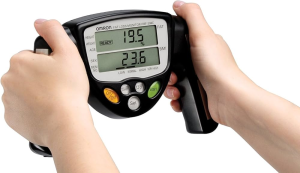Dr. Richa Bhatia
Body fat percentage
Body fat percentage is the total fat mass, as a percentage of total body mass. Body fat includes essential body fat and storage body fat. Essential body fat is necessary to maintain life and reproductive functions. Storage body fat consists of fat accumulation in adipose tissue, part of which protects internal organs in chest and abdomen. The percentage of essential body fat for women is greater than that for men, due to the demands of childbearing and other hormonal functions.

Various measurement techniques are used to measure BF%, such as:
- Underwater weighing
- Air Displacement Plethysmo-graphy (ADP)
- Near-infrared interactance
- Dual energy X-ray absorptiometry
- Bio-electrical Impedance Analysis (BIA)
- Skinfold Method
Near Infra-red Interactance uses a beam of infra-red light, which is transmitted into biceps. This method is noninvasive and easy to use.
DEXA method uses X-rays of two different energies to scan the body, one of which is absorbed more strongly by fat than the other.
Bio-electrical impedance analysis (BIA) is a lower-cost, but less accurate to estimate BF%.
Skinfold Methods are based on a skinfold test, whereby a pinch of skin is measured by calipers, at several standardized points on the body to determine subcutaneous fat thickness. These measurements are converted to an estimated body fat percentage by an equation.
Although it may not give an accurate reading of real body fat percentage, it is a reliable measure of body composition change over a period of time, provided the test is carried out by the same person with the same technique. This method also only measures one type of fat: subcutaneous adipose tissue (fat under the skin). Two individuals might have identical measurements at skinfold sites, yet differ greatly in their body fat levels due to differences in visceral adipose tissue.
Subcutaneous Fat
Sub-cutaneous fat is the layer of subcutaneous tissue that is most widely distributed. It is composed of adipocytes. It acts as padding and as an energy reserve, as well as providing some minor thermo-regulation. Subcutaneous fat is found just beneath the skin, and can be measured using body fat calipers.
Visceral Fat
Visceral fat or abdominal fat is located inside the abdominal cavity (packed between the organs such as stomach, liver, intestines and kidneys). Visceral fat is different from subcutaneous fat underneath the skin and intra-muscular fat. Excess visceral fat (also known as “belly fat”) is linked to type-2 diabetes, insulin resistance, and other obesity-related diseases.
Men are more likely to have fat stored in the abdomen due to hormonal differences. Estrogen (female sex hormone) causes fat to be stored in the buttocks, thighs, and hips in women. When women reach menopause, fat migrates to the waist and the abdomen.
Both exercise and hypo-caloric diet cause loss of visceral fat, but exercise has a larger effect on visceral fat. High-intensity exercise is one way to effectively reduce abdominal fat.
Conclusion
Understanding and management of body fat percentage is crucial for assessing health risks. Different methods measure body fat, with each providing insights into both subcutaneous and visceral fat, impacting overall health and wellness.



